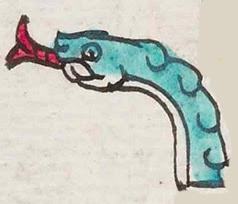Mixcoatl (Mdz5v)
This compound glyph for the deity name Mixcoatl has been duplicated from the entry for the place name Mixcoac. The sign has two fused elements; it is a serpent or snake [coatl) with turquoise-colored clouds (mixtli) built into its back in a scalloped shape. The snake's head and only part of its body is shown. Its head is in profile, facing to the viewer's left. The underside of its body is white. Its bifurcated tongue is red, similar to a flame. Also visible are an eye, a nostril, and fangs. The locative suffix (-c) is not shown visually.
Stephanie Wood
The deity name is close to the place name (Mixcoac), where the absolutive has been switched out for the locative suffix. It may be that this deity had an association with the site of this community. Wikipedia provides quite a bit of information about the deity.
Cloud Serpent was a popular name for Nahua men, especially notable in the Matrícula de Huexotzinco, where the compound glyph differs considerably from this one. According to Sahagún, it was a divine force among the Chichimecs, and carried a powerful significance for the Nahuas. Some scholars have seen it as a divinity associated with hunting, others as part of a Tlaloc complex (of clouds, rain, lightning, etc.), and others as a symbol for a whirlwind (remolino).
Stephanie Wood
Stephanie Wood
c. 1541, but by 1553 at the latest
Stephanie Wood
snakes, serpents, clouds, cohuatl

mix(tli), cloud, https://nahuatl.wired-humanities.org/content/mixtli
coa(tl), serpent or snake, https://nahuatl.wired-humanities.org/content/coatl
Serpiente de la Nubes
Stephanie Wood
Codex Mendoza, folio 5 verso, https://digital.bodleian.ox.ac.uk/objects/2fea788e-2aa2-4f08-b6d9-648c00..., image 21 of 188.
The Bodleian Libraries, University of Oxford, hold the original manuscript, the MS. Arch. Selden. A. 1. This image is published here under the UK Creative Commons, “Attribution-NonCommercial-ShareAlike 3.0 License” (CC-BY-NC-SA 3.0).





